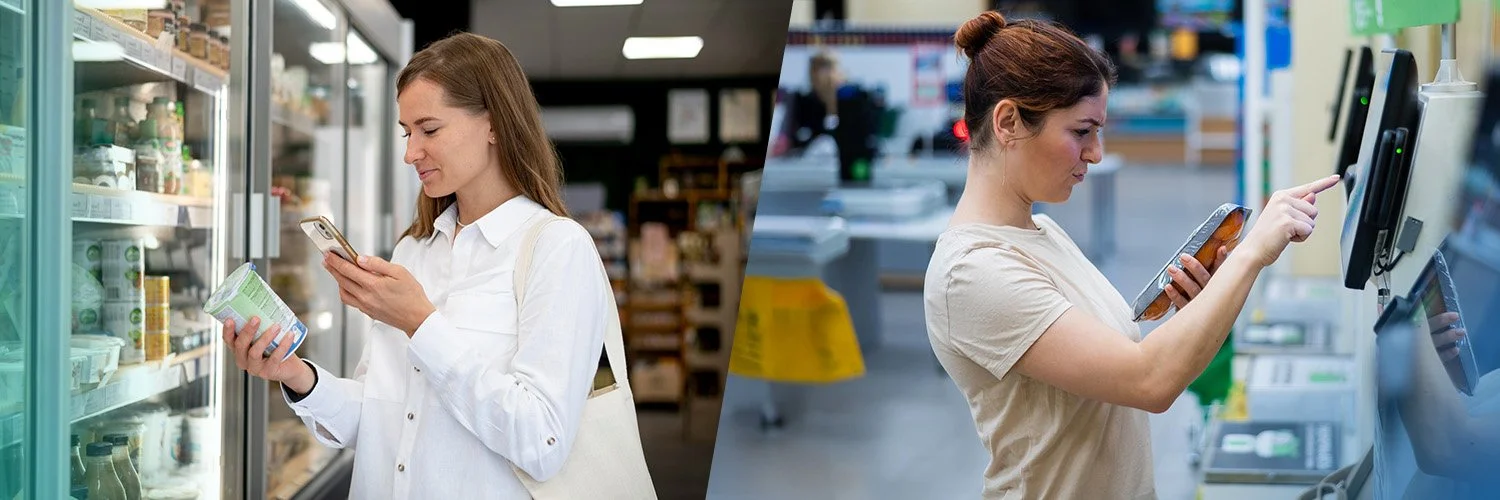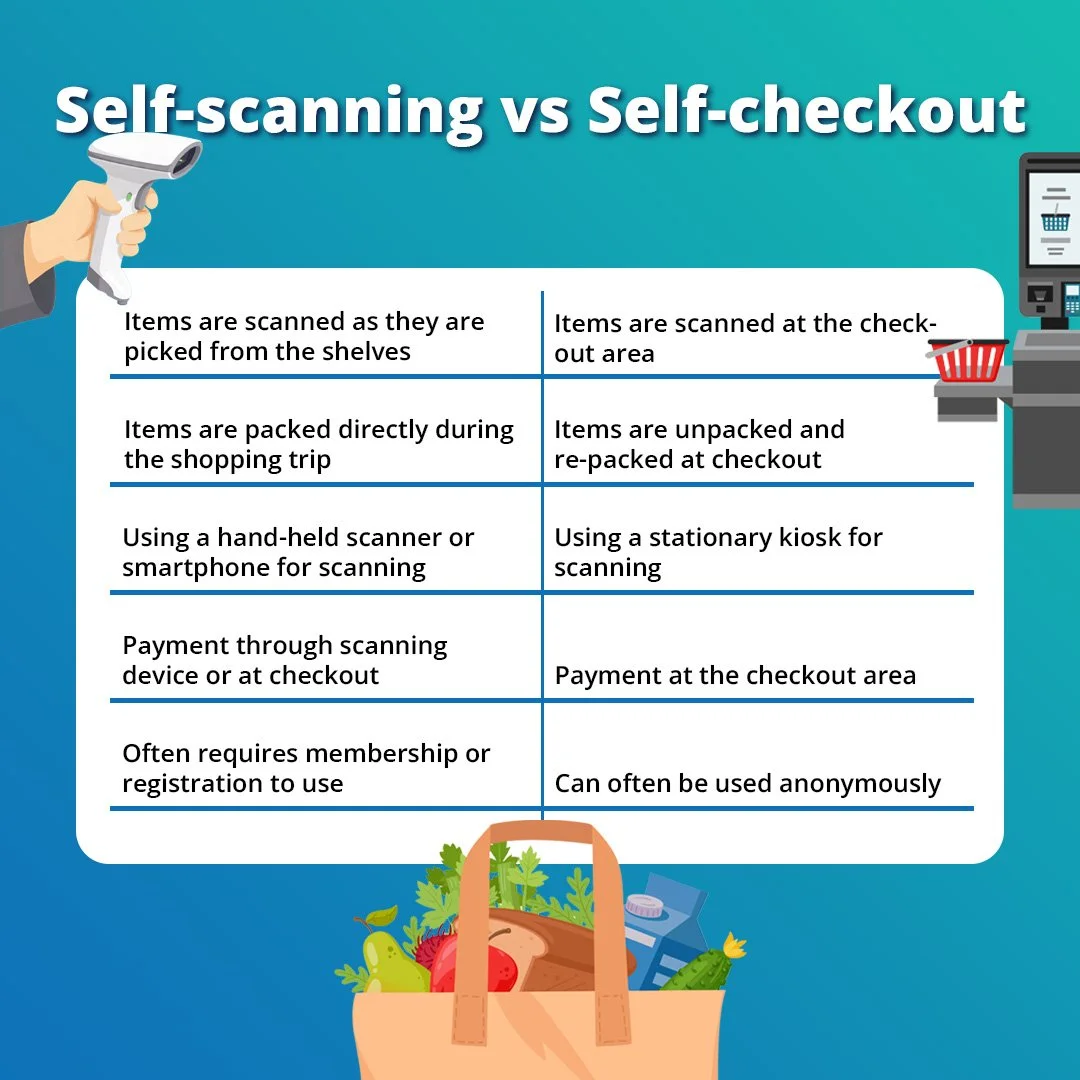Self-scanning vs. Self-checkout
Both self-scanning and self-checkout solutions have gained popularity among retailers over the past decade. The positive effects — for both shoppers and store owners — have been noted in various forums. However, the terms self-scanning and self-checkout are sometimes used interchangeably. While they share similar features, the two concepts differ in both usage and benefits.
Learn more about the differences here!
Self-scanning and self-checkout share both similarities and differences.
A change in retail technology
The retail industry has changed dramatically in the last decades, from new technology changing how business is done, to emerging retail trends and stronger customer preferences regarding everything from sustainability to delivery method and branding.
When attempting to navigate in the evolving retail landscape, retailers have been forced to adapt their business in order to comply with increasing customer expectations. One of these areas is the in-store shopping experience, where both the checkout experience and the shopping trip has developed further.
The customers’ need for greater autonomy and control during the shopping trip has resulted in several solutions – such as self-scanning and self-checkout. Both solutions are focused on using new or refined technologies for customers to handle a greater part of their shopping journey by themselves. It also enables retailers to cut-down or re-distribute the staff force as the number of staffed checkouts can be reduced.
As the development in the retail industry has not been slowed down, various solutions and products connected to the in-store shopping experience are presented each year, it is reasonable to assume there will be even more alternatives for customers in the future.
What is self-scanning?
Self-scanning means that the shopper uses a portable device — either one provided by the retailer or their own smartphone — to scan product barcodes as they shop.
This way, all items have already been scanned before reaching the store’s exit area, and there's no need to unpack or re-pack them at checkout.
How to pay using self-scanning?
When using a self-scanning solution, payment can either be completed directly on the device or at a separate payment terminal near the store exit. The payment method depends on the structure of the self-scanning system and the retailer’s preferences.
Self-scanning with machine vision
Another form of self-scanning was launched by Amazon called Amazon Go. In this type of store, sensors and cameras would notice what products the shopper put in their basket, and thereby charge the customer for it after leaving the store. It has had moderate success, primarily due to the required investments and the amount of technolgy needed.
What is self-checkout?
Self-checkout means that the need for a staffed checkout is removed, as customers scan their products and complete payment on their own, using a self-checkout machine located near the store exit. Self-checkout is also referred to as self-service checkout or assisted checkout.
How does self-checkout work?
The customer collects all items they want to purchase in the store, and thereafter registers them in the self-checkout machine. Usually, the products have a barcode that is scanned, but there is usually the possibility to weigh specific products in order to get the correct price as well. Another alternative for the registration of products is by using cameras that are strategically placed in the checkout to identify all products. Another modern version of the traditional self-checkout is the use of ai to identify and scan all items.
However, due to practicality reasons, there is often a limit to how many items one may bring to the self-service checkout. The absence of a conveyor belt makes it impractical to scan a lot of items, both for the customer and the self-checkout machine.
What are the differences between self-scanning and self-checkout?
The main differences between self-scanning and self-checkout are:
With self-scanning, products are scanned throughout the shopping journey and do not need to be registered again at the end. In contrast, with self-checkout, items are scanned at the end of the shopping trip.
Self-scanning involves using a portable device, while self-checkout requires scanning and payment at a fixed machine located near the store exit.
Self-checkout tends to have higher shrinkage, as it often allows for anonymous shopping. In contrast, self-scanning typically requires a membership or loyalty card, making it possible to block users who misuse the system and prevent them from using it again.
So with a self-scanning setup, the shopper is using the solution throughout the shopping journey - from start to finish. The scanning device, whether it is a dedicated scanner or the customer’s smartphone, is used throughout the shopping trip, and can even be used for payment. Moreover, the features of the self-scanning software can provide several smart additions and improvements for the shopper.
How to choose between self-scanning and self-checkout?
For retailers, choosing between implementing self-scanning or a self-checkout system might not be an easy decision. There are many variables to take into consideration before selecting which solution to implement. Here are some of the factors that needs to be considered before making a decision:
Store size
The store size, as well as the average number of customers, can greatly impact the decision making. A retailer must ask themselves: Is there enough space for self-checkout machines? Even though this type of machinery requires less space than traditional cashiers with conveyor belts, it is still reasonable to believe that at least one traditional cash register needs to be kept. Thereby, the store size determines how many self-checkouts that can be installed. If the store size is particularly small, self-scanning might be the only option.
Technological maturity
Are the customers in your region used to self-scanning or self-checkout? This is a factor that can vary greatly depending on the country, region and the culture. In places where the customers have reached technological maturity, introducing more technologically advanced self-scanning such as scanning with smartphone app (BYOD) might be the best choice. In other places, where the customers are not used to anything else but the traditional conveyor belt, self-checkout machines or retailer-owned devices (ROD) for self-scanning can be more suitable.
Store mission
Obviously, there are many benefits with both self-scanning and self-checkout, however the retailer should select the solution that aligns the best with their own goals. Is it to reduce staff, enhance the customer experience while minimizing shrinkage, or to offer the latest technology? Some retailers might see an opportunity to attract more customers to the store, and to have a higher customer flow. Regardless of the reasoning behind, it should affect the choice.
The choice between self-scanning and self-checkout is not easy. However, it is worth mentioning that retailers do not necessarily have to make a choice between the two set-ups. In fact, it has become more common that stores provide both self-scanning and self-checkout for their customers. This is a good way to increase the level of autonomous shopping, regardless if the scanning take place in the store or at the exit. Moreover, by placing the payment tower for self-scanning in close proximity to the self-checkout area, one can utilise the staff in a efficient and customer-friendly way.





